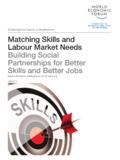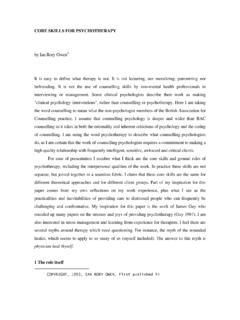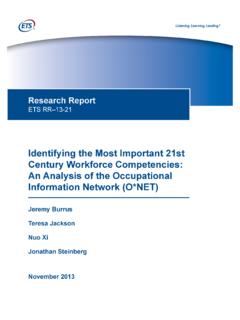Transcription of STEM Education Must Start in Early Childhood
1 Published Online: March 5, 2013 Published in Print: March 6, 2013, as Why STEM Education must Start in Early Childhood COMMENTARY STEM Education must Start in Early Childhood By JD Chesloff According to a 2010 survey by Change the Equation, a nonprofit, nonpartisan corporate initiative to further math and science learning, nearly one-third of Americans would rather clean their bathrooms than do a math problem. In a globally competitive economy, with employers of all shapes and sizes increasingly seeking workers skilled in science, technology, engineering, and math, this is humorous and more than a little troubling. Investing to ensure a pipeline of workers skilled in STEM competencies is a workforce issue, an economic-development issue, and a business imperative. And the best way to ensure return on these investments is to Start fostering these skills in young children.
2 It is becoming increasingly difficult to define a STEM "job." Regardless of the industry manufacturing, utilities, construction, technology, financial services employers are looking for a talent pipeline that can produce workers proficient in the STEM disciplines. Concepts at the heart of STEM curiosity, creativity, collaboration, and critical thinking are in demand. They also happen to be innate in young children. As employers look at the workforce pipeline over time, they ask themselves a simple question: Where are we going to find workers? There is cause for concern: According to a 2010 study from Georgetown University's Center on Education and the Workforce, about 76 million baby boomers will soon retire, and only about 51 million people are in line to replace them, creating a "worker gap" of 25 million.
3 This past summer, the Center for American Progress and the Center for the Next Generation released a joint report showing that more than half of postsecondary students drop out without receiving a degree. And perhaps most alarming of all, of the 39 million young adults in the United States ages 17 to 24, the Pentagon reports that 75 percent do not qualify to join the military because they cannot meet the physical, behavioral, or educational standards for service standards that are similar to those many industries use in hiring. When it comes to STEM jobs, the pipeline issue is complicated further. The Department of Commerce projected that in the decade leading up to 2018, STEM occupations would grow by 17 percent, compared with percent growth for all other occupations. Across the country, across all occupations, there are people for every one job.
4 In STEM fields, there is one person for every jobs. Employers can't find the talent to fill these jobs, which is even more surprising considering that the Census Bureau recently reported that the median salary for engineering majors was the highest of any profession. Supply is low and demand is high. There is a mismatch between projected future jobs requiring STEM skills and the projected supply of qualified workers to fill them. In 2009, at the urging of the Massachusetts Business Roundtable and a coalition of business leaders working closely with the state's lieutenant governor, Tim Murray, Gov. Deval Patrick created the Governor's STEM Advisory Council to develop a state STEM plan that would ensure that the Education pipeline from pre-K through higher Education is producing workers who are skilled in STEM competencies.
5 The implementation strategy has a component focused on pre-K. Both the plan and the implementation are now national models. There are many ideas about the most effective entry point in the Education system for making an impact on student interest and achievement in STEM. Some say high school. Some say that's too late. Some say middle school. Some say 3rd grade. The Raytheon Co., one of Massachusetts' leading employers of STEM professionals, conducted a survey of 1,000 middle school students across the country and asked them if they preferred doing math homework or eating broccoli. The winner, with 56 percent of the vote was .. broccoli. It is my feeling that you can't Start Early enough: Young children are natural-born scientists and engineers. Like STEM, investment in Early - Childhood Education is a workforce-pipeline issue.
6 Research has shown that high-quality pre-K cuts the rate of children being held back a grade in half; decreases juvenile arrests by a third; and increases high school attendance by a third, college attendance by a whopping 80 percent, and employment by 23 percent. High-quality Early -learning environments provide children with a structure in which to build upon their natural inclination to explore, to build, and to question. There is an exciting and powerful link between STEM and Early Childhood . Research confirms that the brain is particularly receptive to learning math and logic between the ages of 1 and 4, and that Early math skills are the most powerful predictors of later learning. Research from the University of California, Irvine, confirms that Early math skills are a better predictor of later academic success than Early reading is.
7 The study found that in a comparison of math, literacy, and social-emotional skills at kindergarten entry, " Early math concepts, such as knowledge of numbers and ordinality, were the most powerful predictors of later learning." "If math skills are such an important component of academic success, but people would rather be cleaning their bathrooms or eating broccoli, I d say we have a problem." If math skills are such an important component of academic success, but people would rather be cleaning their bathrooms or eating broccoli, I'd say we have a problem. Math skills and other STEM competencies are important to the country's long-term competitiveness because today's young children are tomorrow's workforce. Workers who are fluent in these competencies will be more prepared and qualified to fill the jobs that our innovation economy demands.
8 This concept is integrated into the Massachusetts Education system, beginning at the earliest stages. The strategic plan of the Massachusetts Department of Early Education and Care officially recognizes that "inquiry and exploration are foundations for math and science and are also the foundations for Early learning." The department's commissioner, Sherri Killins, has made remarkable strides in linking STEM and Early Childhood by encouraging STEM professional-development opportunities for Early - Childhood educators, aligning state standards and frameworks by ensuring a pre-K component to math and science standards, and intentionally integrating STEM into daily activities with students through curricula and quality measurements through the state's Quality Rating and Improvement System. Massachusetts has engaged in productive partnerships with the private sector as well, including tens of thousands of dollars in donated hardware and software from IBM to support the state's implementation of its Race to the Top Early Learning Challenge grant from the federal government.
9 Other companies, like National Grid, John Hancock, and JP Morgan Chase are also supporting efforts in the state to explore innovative ways to bolster the Early Childhood workforce. And why wouldn't they? International competition for talent is getting stiffer. As the Center for American Progress and the Center for the Next Generation study points out, "half of children get no Early - Childhood Education , and we have no national strategy to increase enrollment," while China, for example, has plans to enroll 40 million children in preschool, an increase of 50 percent, by 2020. Just for some context, there are a total of about 24 million children from birth to age 5 in the United States. By 2030, China will have 200 million college graduates, more than the entire workforce. Which gets back to the original point: Where are employers going to find workers?
10 To remain competitive in the global economy, investment is needed to ensure a workforce pipeline that would rather engage in science, technology, engineering, and math than cleaning bathrooms and eating broccoli. And the best way to shore up that pipeline is to Start investing in it Early . JD Chesloff has served as the executive director of the Massachusetts Business Roundtable since 2011. He is the chair of the Massachusetts Board of Early Education and Care and also chairs the executive committee of the state governor's stem advisory council. Illustration by Kali Ciesemier








